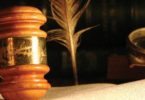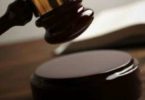Sample Practice Questions for Law School Admission Test – India LLB entrance exam. This paper contains 40 questions with answers which You can download in PDF from link given below the last question.
Directions (next 5 questions): In each of the questions below, two statements are given followed by two conclusions numbered I and II. You have to take the two statements to be true even if they seem to be at variance with commonly known facts and then decide which of the given conclusions logically follows from the given statements, disregarding commonly known facts. Give answer
(a) if only conclusion I follows.
(b) if only conclusion II follows.
(c) if either conclusion I or conclusion II follows.
(d) if neither conclusion I nor conclusion II follows.
Question: Statements:
All scooters are vehicles.
No vehicle is a four-wheeler.
Conclusions:
I. All scooters being four-wheelers is a possibility.
II. Some four-wheelers may be scooters.
Question: Statements:
Some pencils are black.
Some pens are pencils.
Conclusions:
I. Some pencils are pens.
II. No pen is black.
Question: Statements:
No doctor is rich.
All professionals are doctors.
Conclusions:
I. Some rich which are not doctors may be professionals.
II. Some rich being professional is a possibility.
Question: Statements:
Some poor are honest.
Some honest are sharp.
Conclusions:
I. Some poor being sharp or honest is a possibility.
II. At least some poor will be sharp.
Question: Statements:
All shares are debentures.
No debenture is an equity.
Conclusions:
I. At least some equities are not share.
II. That an equity is a share is a possibility.
Related: equation of Line Questions
Directions (for next 5 questions): In each of the questions below four sentences are given which are denoted by A, B, C and D. By using all four sentences, frame a meaningful para. Choose answer from the five alternatives given and the correct order of the sentences is your answer.
Question: (A) India’s patent authorities are at the centre of global attention.
(B) India’s patent law is equipped to drive out frivolous patent seekers and to reward meritorious inventors
(C) If successful, Indian generic drug-makers may have to pay royalties.
(D) As many MNC drug-makers have applied for patents under India’s new product patent law
(a) ABCD
(b) ADCB
(c) BACD
(d) DACB
Question: (A) What’s more, if you happen to be inching towards retirement, your EMIs will be structured accordingly.
(B) Future credit may get customised.
(C) The next time you get a hike in your company, rest assured your Equated Monthly Instalments (EMIs) will go up.
(D) EMIs will now be fixed according to your affordability.
(a) DCAB
(b) BCAD
(c) BCDA
(d) ABCD
Question: (A) The Tax Return Prepares Scheme has been introduced recently to help individuals file their income tax returns.
(B) According to this scheme, certain tax return prepares will be specially trained.
(C) The aim is to ease the process of filing returns and reduce the cost for tax payers.
(D) However, individuals should carefully examine this service and its likely benefits.
(a) ABCD
(b) ADCA
(c) DABC
(4) BACD
Question: (A) There is nothing more soothing to the mind, body and soul than being on the beach front.
(B) That’s what Archil, which buys bad loans, thinks.
(C) A little bit of business can also be thrown in such a setting.
(D) The ARC thought of the idea of organising a workshop on junk bonds in an exotic beach resort in Goa and has roped in the Indian Bank’s Association.
(a) DCAB
(b) ABCD
(c) DACB
(d) ACBD
Question: (A) The financial markets in the country have provided a wide array of such instruments.
(B) Doing business is all about managing risk.
(C) The profit and loss account is a reflection of the risk that is dexterously handled by CFOs.
(D) Which have been seized with alacrity by the industry.
(a) BACD
(b) ABCD
(c) ACBD
(d) BCAD
Question: What is the maximum strength of members of the House of the People chosen by direct election under the Constitution of India?
(a) 530
(b) 550
(c) 552
(d) 540
Question: How many such pairs of letters are there in the word EXPERIMENT each of which have as many letters between them in the word as they have in the English alphabet?
(a) None
(b) One
(c) Two
(d) Three
Directions (for next 6 questions): Study the following information carefully and answer the questions given below: A, B, C, D, E, F, G, H and J are sitting around a circle facing the centre. C is third to the left of A. E is fourth to the right of A. D is fourth to the left of J, who is second to the right of A. F is third to the right of B. G is not an immediate neighbour of A.
Question: Who is on the immediate right of D?
(a) F
(b) C
(c) A
(d) Data inadequate
Question: Who is second to the left of H?
(a) A
(b) F
(c) D
(d) Data inadequate
Question: Who is third to the right of G?
(a) B
(b) D
(c) A
(d) None of these
Question: Who is fifth to the right of E?
(a) F
(b) C
(c) H
(d) A
Question: Pointing to a photograph Rasika said “He is the grandson of my grandmother’s only son.” How is the boy in photograph related to Rasika ?
(a) Son
(b) Nephew
(c) Brother
(d) Cannot be determined
Question: In which of the following groups is the third person sitting between the first and the second persons?
(a) CDF
(b) EBC
(c) HFA
(d) JGE
Question: What is H’s position with respect to E?
(a) Third to the left
(b) Fourth to the left
(c) Fifth to the right
(d) Fifth to the left
Question: Under which law a minor is incapable of entering into contract?
(a) Indian Contract Act, 1872
(b) Majority Act, 1875
(c) Guardians and Wards Act, 1890
(d) Contract Labour ((Regulation and Abolition) Act, 1970
Related: Excel multiple choice questions
Question: The principle of ‘collective responsibility’ means –
(a) all citizens must collectively elect their representatives
(b) all members of the union council of ministers are collectively responsible to the House of the People
(c) all Ministers are accountable to the Parliament
(d) all ministers hold office at the pleasure of the Prime Minister.
Direction for next 4 questions: In each of the questions below are given four statements followed by three conclusions numbered I, II and III. You have to take the given statements to be true even if they seem to be at variance from commonly known facts. Read all the conclusions and then decide which of the given conclusions logically follows from the given statements disregarding commonly known facts.
Question:
Statements :
Some shoes are socks.
All socks are towels.
All towels are bedsheets.
No bedsheet is blanket.
Conclusions :
I. No towel is blanket.
II. Some shoes are towels.
III. Some shoes are bedsheets.
(a) Only I and II follow
(b) Only II and III follow
(c) Only I and III follow
(d) All follow
Question:
Statements :
Some fruits are flowers.
Some flowers are buds.
No bud is leaf.
All leaves are plants.
Conclusions :
I. No plant is bud.
II. Some plants are flowers.
III. Some buds are fruits.
(a) None follows
(b) Only I follows
(c) Only II and III follow
(d) Only III follows
Question:
Statements :
Some pearls are gems.
Some gems are diamonds.
All diamonds are rings.
All rings are bangles.
Conclusions :
I. Some bangles are rings.
II. All rings are diamonds.
III. All diamonds are bangles.
(a) Only I follows
(b) Only I and II follow
(c) Only I and III follow
(d) All follow
Question:
Statements :
All chairs are tables.
All tables are telephones.
All telephones are cell phones.
No cell phone is computer.
Conclusions :
I. All cell phones are tables.
II. Some chairs are computers.
III. No chair is computer.
(a) Only I follows
(b) Only II follows
(c) Only III follows
(d) Only either II or III follows
Question:
Statements :
Some rocks are hills.
All hills are mountains.
All mountains are rivers.
No river is Canal.
Conclusions :
I. All rocks are rivers.
II. Some hills are canals.
III. Some rivers are canals.
(a) Only I follows
(b) Only II and III follow
(c) Only I and III follow
(d) None follows
Question: The trade practice known as “minimum resale price maintenance” is prohibited by –
(a) Monopolies and Restrictive Trade Practices Act, 1969
(b) Competition Act, 2002
(c) Consumer Protection Act, 1986
(d) Multi-State Co-operative Societies Act, 2002
Question: The private detective deliberately choose _______ clothes.
(a) decrepit
(b) nondescript
(c) flashy
(d) derisive
Question: The ship managed to survive the nasty weather by casting its goods overboard, but this _______ will pose a nuisance to the residents on the shore.
(a) traffic
(b) jetsam
(c) flotsam
(d) noise
Related: 10 facts about Earth
Question: The prohibition against employment of children below 14 years of age has been provided –
(a) as a fundamental right against exploitation in the Constitution
(b) as a right to equality
(c) as a directive principle of state policy
(d) as a duty on the parents and guardians
Question: Find the missing number:
123 : 4 : : 726 : ?
(a) 23
(b) 26
(c) 14
(d) 12
Question: How many fundamental rights have been guaranteed under the Constitution of India?
(a) 5
(b) 6
(c) 7
(d) 8
Question: In the question below are given two statements followed by four conclusions numbered I, II, III, and IV. You have to take the two given statements to be true even if they seem to be at variance from commonly known facts. Read the conclusions and then decide which of the given conclusions logically follow the two given statements, disregarding commonly known facts.
Statements.: A. All statutes of legislature are law of the land. B. Judge made law is laid down by the Courts.
Conclusions: I. Constitution is a statute. II. Both statutes and judge made law form the law of the land. III. Courts make statutes. IV. Judge made law is superior to statutes.
(a) Both I and IV follow.
(b) Only IV follows.
(c) Only II follows.
(d) None follows.
Question: The police investigator tried hard to _________ some response from the criminal but the criminal refused to divulge any information of his ________ operation.
(a) elicit, illicit
(b) illicit, elicit
(c) illicit, illegitimate
(d) get, elicit
Related: Architects and their Buildings
Question: Which is the following is not a synonym to the word ‘Parochial’?
(a) Provincial
(b) Insular
(c) Limited
(d) Preferable
Question: Which is the following is not a synonym to the word ‘Parsimonious’?
(a) Penurious
(b) Miserly
(c) Acrimonious
(d) Niggard
Question: Vishal drives 30 km south. Then he turns right and drives another 30 km. Turning left from here, he drives 20 km. Finally turning left, he drives 30km. How far is Vishal from his starting position?
(a) 30 km
(b) 20 km
(c) 80 km
(d) None of these
Related: FIFA trivia questions and answers
Question: Anand is more hard working than Bhuvan but he is not as hard working as Chander. Dheeraj is less hard working than Chander but more hard working than Anand. If Chander is the most hard working individual, who is the least hard working of them?
(a) Bhuvan
(b) Anand
(c) Dheeraj
(d) Both Bhuvan and Dheeraj







Saharsa district in all youth’s traning devlopment
hello frinds
sir,i am apply the form for 5 years LLB enterance paper,
sir plese any suggest for preparation book